mirror FORD TRANSIT 2006 7.G Body And Equipment Mounting Section Manual
[x] Cancel search | Manufacturer: FORD, Model Year: 2006, Model line: TRANSIT, Model: FORD TRANSIT 2006 7.GPages: 234, PDF Size: 33.19 MB
Page 4 of 234
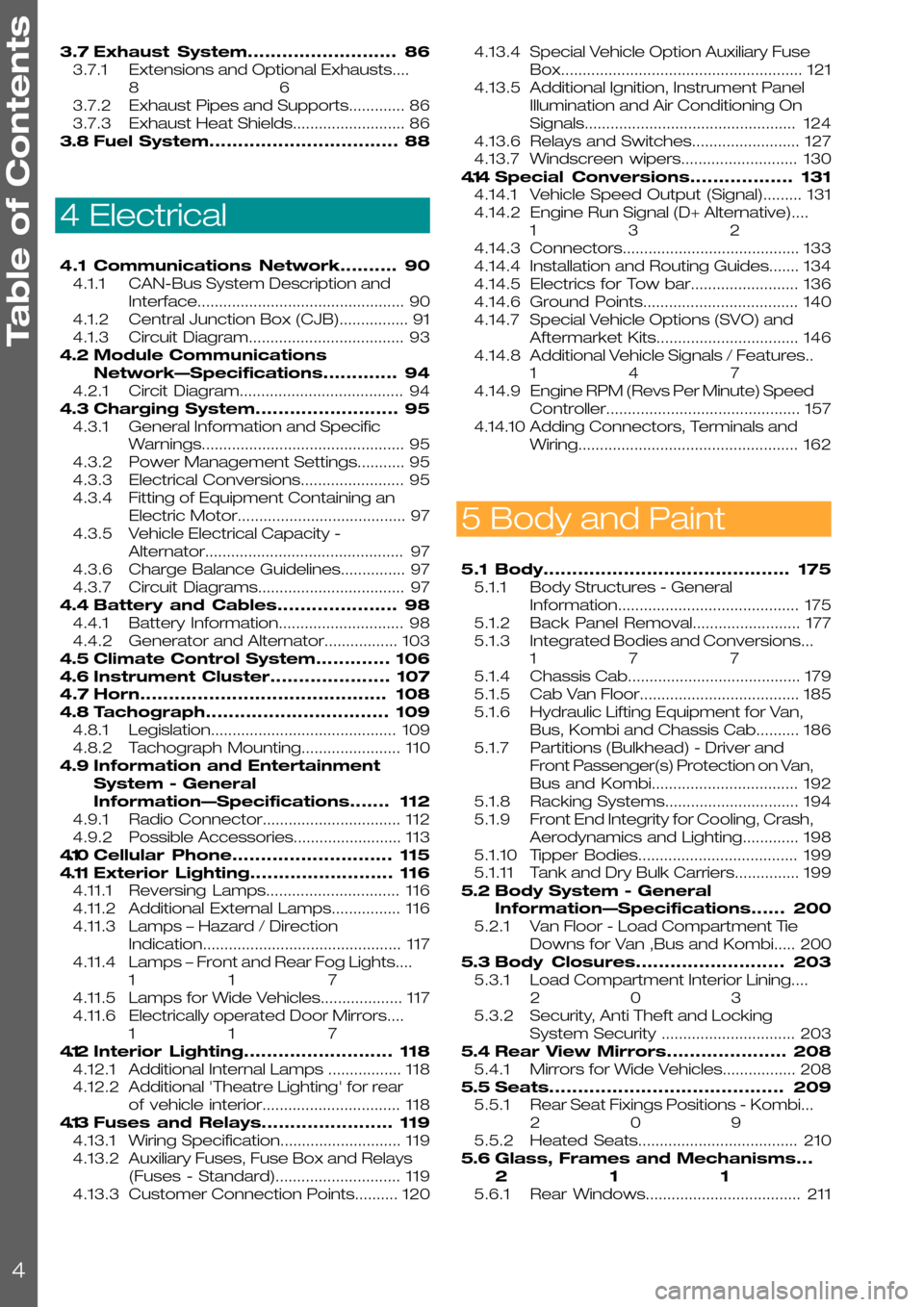
3.7Exhaust System..........................86
3.7.1Extensions and Optional Exhausts....
86
3.7.2Exhaust Pipes and Supports.............86
3.7.3Exhaust Heat Shields..........................86
3.8Fuel System.................................88
4 Electrical
4.1Communications Network..........90
4.1.1CAN-Bus System Description and
Interface................................................90
4.1.2Central Junction Box (CJB)................91
4.1.3Circuit Diagram....................................93
4.2Module Communications
Network—Specifications.............94
4.2.1Circit Diagram......................................94
4.3Charging System.........................95
4.3.1General Information and Specific
Warnings...............................................95
4.3.2Power Management Settings...........95
4.3.3Electrical Conversions........................95
4.3.4Fitting of Equipment Containing an
Electric Motor.......................................97
4.3.5Vehicle Electrical Capacity -
Alternator..............................................97
4.3.6Charge Balance Guidelines...............97
4.3.7Circuit Diagrams..................................97
4.4Battery and Cables.....................98
4.4.1Battery Information.............................98
4.4.2Generator and Alternator.................103
4.5Climate Control System.............106
4.6Instrument Cluster.....................107
4.7Horn...........................................108
4.8Tachograph................................109
4.8.1Legislation...........................................109
4.8.2Tachograph Mounting.......................110
4.9Information and Entertainment
System - General
Information—Specifications.......112
4.9.1Radio Connector................................112
4.9.2Possible Accessories.........................113
4.10Cellular Phone............................115
4.11Exterior Lighting.........................116
4.11.1Reversing Lamps...............................116
4.11.2Additional External Lamps................116
4.11.3Lamps – Hazard / Direction
Indication..............................................117
4.11.4Lamps – Front and Rear Fog Lights....
117
4.11.5Lamps for Wide Vehicles...................117
4.11.6Electrically operated Door Mirrors....
117
4.12Interior Lighting..........................118
4.12.1Additional Internal Lamps .................118
4.12.2Additional 'Theatre Lighting' for rear
of vehicle interior................................118
4.13Fuses and Relays.......................119
4.13.1Wiring Specification............................119
4.13.2Auxiliary Fuses, Fuse Box and Relays
(Fuses - Standard).............................119
4.13.3Customer Connection Points..........120
4.13.4Special Vehicle Option Auxiliary Fuse
Box........................................................121
4.13.5Additional Ignition, Instrument Panel
Illumination and Air Conditioning On
Signals.................................................124
4.13.6Relays and Switches.........................127
4.13.7Windscreen wipers...........................130
4.14Special Conversions..................131
4.14.1Vehicle Speed Output (Signal).........131
4.14.2Engine Run Signal (D+ Alternative)....
132
4.14.3Connectors.........................................133
4.14.4Installation and Routing Guides.......134
4.14.5Electrics for Tow bar.........................136
4.14.6Ground Points....................................140
4.14.7Special Vehicle Options (SVO) and
Aftermarket Kits.................................146
4.14.8Additional Vehicle Signals / Features..
147
4.14.9Engine RPM (Revs Per Minute) Speed
Controller.............................................157
4.14.10Adding Connectors, Terminals and
Wiring...................................................162
5 Body and Paint
5.1Body...........................................175
5.1.1Body Structures - General
Information..........................................175
5.1.2Back Panel Removal.........................177
5.1.3Integrated Bodies and Conversions...
177
5.1.4Chassis Cab........................................179
5.1.5Cab Van Floor.....................................185
5.1.6Hydraulic Lifting Equipment for Van,
Bus, Kombi and Chassis Cab..........186
5.1.7Partitions (Bulkhead) - Driver and
Front Passenger(s) Protection on Van,
Bus and Kombi..................................192
5.1.8Racking Systems...............................194
5.1.9Front End Integrity for Cooling, Crash,
Aerodynamics and Lighting.............198
5.1.10Tipper Bodies.....................................199
5.1.11Tank and Dry Bulk Carriers...............199
5.2Body System - General
Information—Specifications......200
5.2.1Van Floor - Load Compartment Tie
Downs for Van ,Bus and Kombi.....200
5.3Body Closures..........................203
5.3.1Load Compartment Interior Lining....
203
5.3.2Security, Anti Theft and Locking
System Security ...............................203
5.4Rear View Mirrors.....................208
5.4.1Mirrors for Wide Vehicles.................208
5.5Seats.........................................209
5.5.1Rear Seat Fixings Positions - Kombi...
209
5.5.2Heated Seats.....................................210
5.6Glass, Frames and Mechanisms...
211
5.6.1Rear Windows....................................211
Table of Contents
4
Page 34 of 234

1.14 Package and Ergonomics—Specifications
1.14.1 Recommended Main Dimensions
WARNING: Do not modify the
wheelbase or add any type of frame
extension to vehicles fitted with
Interactive Vehicle Dynamics
(IVD)/Electronic Stability Program
ESP
NOTE: Extreme rear overhang may encourage
unacceptable loading conditions, which could
unload the front axle producing unacceptable
handling and braking characteristics
NOTE: When extending the length of the
wheelbase during conversion, do not increase
the overall length more than 50% of the
wheelbase of the donor vehicle. The maximum
legal overhang of the donor vehicle is 60%.
If a conversion requires more than 50% overhang,
please contact one of the below.
NOTE: For further information please contact
your local National Sales Company representative,
or Local Ford Dealer. If they are unable to help
you then please contact the Vehicle Converter
Advisory Service at [email protected].
The Special Vehicle Option 2.3m body Width pack
includes long arm mirrors and side repeater
lamps. Please check for availability.
FordTransit 2006.5 (April 2006–)
Date of Publication: 12/2006
1 General Information
34
Page 36 of 234
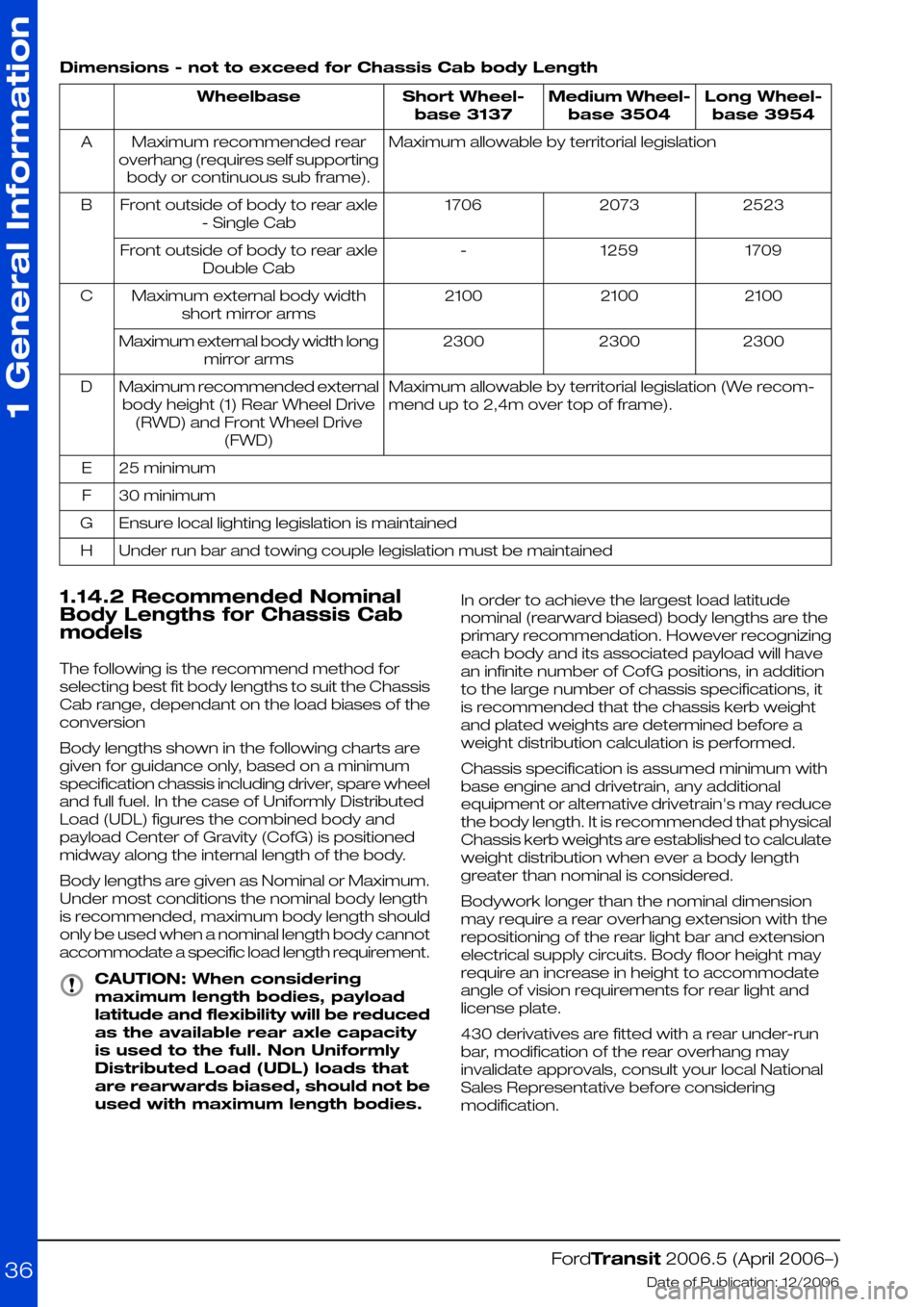
Dimensions - not to exceed for Chassis Cab body Length
Long Wheel-
base 3954
Medium Wheel-
base 3504
Short Wheel-
base 3137
Wheelbase
Maximum allowable by territorial legislationMaximum recommended rear
overhang (requires self supporting
body or continuous sub frame).
A
252320731706Front outside of body to rear axle
- Single Cab
B
17091259-Front outside of body to rear axle
Double Cab
210021002100Maximum external body width
short mirror arms
C
230023002300Maximum external body width long
mirror arms
Maximum allowable by territorial legislation (We recom-
mend up to 2,4m over top of frame).
Maximum recommended external
body height (1) Rear Wheel Drive
(RWD) and Front Wheel Drive
(FWD)
D
25 minimumE
30 minimumF
Ensure local lighting legislation is maintainedG
Under run bar and towing couple legislation must be maintainedH
1.14.2 Recommended Nominal
Body Lengths for Chassis Cab
models
The following is the recommend method for
selecting best fit body lengths to suit the Chassis
Cab range, dependant on the load biases of the
conversion
Body lengths shown in the following charts are
given for guidance only, based on a minimum
specification chassis including driver, spare wheel
and full fuel. In the case of Uniformly Distributed
Load (UDL) figures the combined body and
payload Center of Gravity (CofG) is positioned
midway along the internal length of the body.
Body lengths are given as Nominal or Maximum.
Under most conditions the nominal body length
is recommended, maximum body length should
only be used when a nominal length body cannot
accommodate a specific load length requirement.
CAUTION: When considering
maximum length bodies, payload
latitude and flexibility will be reduced
as the available rear axle capacity
is used to the full. Non Uniformly
Distributed Load (UDL) loads that
are rearwards biased, should not be
used with maximum length bodies.
In order to achieve the largest load latitude
nominal (rearward biased) body lengths are the
primary recommendation. However recognizing
each body and its associated payload will have
an infinite number of CofG positions, in addition
to the large number of chassis specifications, it
is recommended that the chassis kerb weight
and plated weights are determined before a
weight distribution calculation is performed.
Chassis specification is assumed minimum with
base engine and drivetrain, any additional
equipment or alternative drivetrain's may reduce
the body length. It is recommended that physical
Chassis kerb weights are established to calculate
weight distribution when ever a body length
greater than nominal is considered.
Bodywork longer than the nominal dimension
may require a rear overhang extension with the
repositioning of the rear light bar and extension
electrical supply circuits. Body floor height may
require an increase in height to accommodate
angle of vision requirements for rear light and
license plate.
430 derivatives are fitted with a rear under-run
bar, modification of the rear overhang may
invalidate approvals, consult your local National
Sales Representative before considering
modification.
FordTransit 2006.5 (April 2006–)
Date of Publication: 12/2006
1 General Information
36
Page 91 of 234
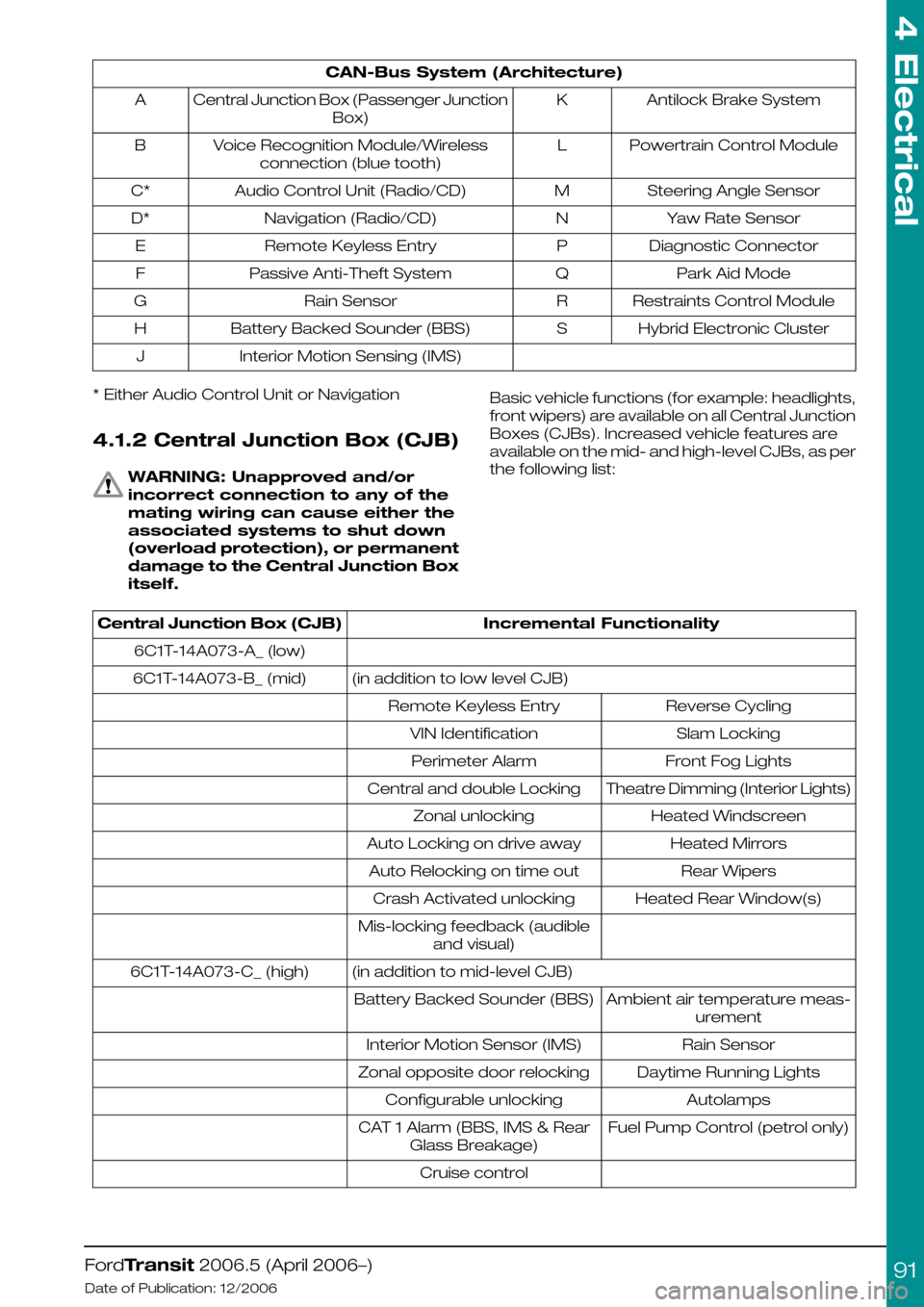
CAN-Bus System (Architecture)
Antilock Brake SystemKCentral Junction Box (Passenger Junction
Box)
A
Powertrain Control ModuleLVoice Recognition Module/Wireless
connection (blue tooth)
B
Steering Angle SensorMAudio Control Unit (Radio/CD)C*
Yaw Rate SensorNNavigation (Radio/CD)D*
Diagnostic ConnectorPRemote Keyless EntryE
Park Aid ModeQPassive Anti-Theft SystemF
Restraints Control ModuleRRain SensorG
Hybrid Electronic ClusterSBattery Backed Sounder (BBS)H
Interior Motion Sensing (IMS)J
* Either Audio Control Unit or Navigation
4.1.2 Central Junction Box (CJB)
WARNING: Unapproved and/or
incorrect connection to any of the
mating wiring can cause either the
associated systems to shut down
(overload protection), or permanent
damage to the Central Junction Box
itself.
Basic vehicle functions (for example: headlights,
front wipers) are available on all Central Junction
Boxes (CJBs). Increased vehicle features are
available on the mid- and high-level CJBs, as per
the following list:
Incremental FunctionalityCentral Junction Box (CJB)
6C1T-14A073-A_ (low)
(in addition to low level CJB)6C1T-14A073-B_ (mid)
Reverse CyclingRemote Keyless Entry
Slam LockingVIN Identification
Front Fog LightsPerimeter Alarm
Theatre Dimming (Interior Lights)Central and double Locking
Heated WindscreenZonal unlocking
Heated MirrorsAuto Locking on drive away
Rear WipersAuto Relocking on time out
Heated Rear Window(s)Crash Activated unlocking
Mis-locking feedback (audible
and visual)
(in addition to mid-level CJB)6C1T-14A073-C_ (high)
Ambient air temperature meas-
urement
Battery Backed Sounder (BBS)
Rain SensorInterior Motion Sensor (IMS)
Daytime Running LightsZonal opposite door relocking
AutolampsConfigurable unlocking
Fuel Pump Control (petrol only)CAT 1 Alarm (BBS, IMS & Rear
Glass Breakage)
Cruise control
FordTransit 2006.5 (April 2006–)
Date of Publication: 12/2006
4 Electrical
91
Page 112 of 234
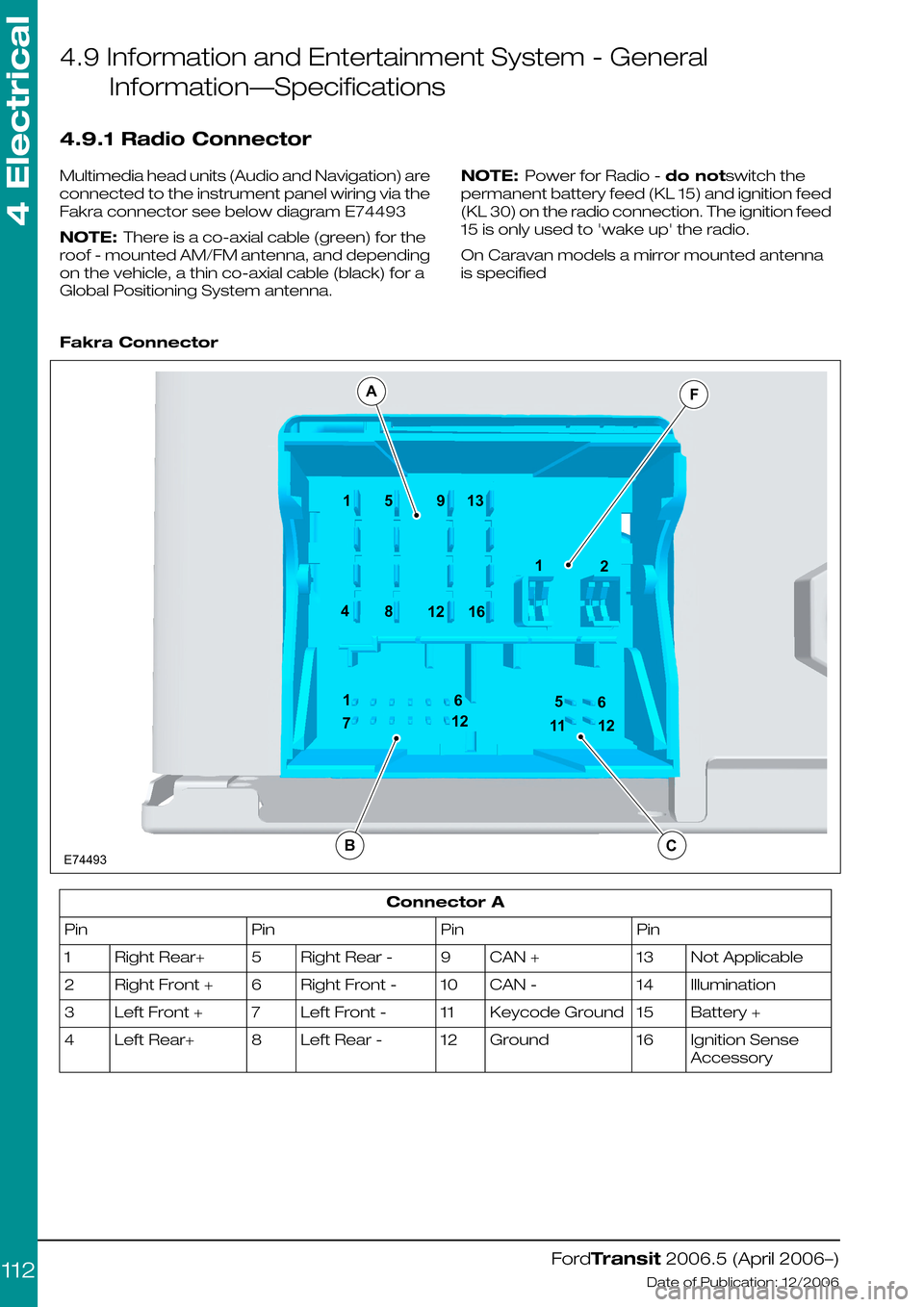
4.9 Information and Entertainment System - General
Information—Specifications
4.9.1 Radio Connector
Multimedia head units (Audio and Navigation) are
connected to the instrument panel wiring via the
Fakra connector see below diagram E74493
NOTE: There is a co-axial cable (green) for the
roof - mounted AM/FM antenna, and depending
on the vehicle, a thin co-axial cable (black) for a
Global Positioning System antenna.
NOTE: Power for Radio - do notswitch the
permanent battery feed (KL 15) and ignition feed
(KL 30) on the radio connection. The ignition feed
15 is only used to 'wake up' the radio.
On Caravan models a mirror mounted antenna
is specified
Fakra Connector
Connector A
PinPinPinPin
Not Applicable13CAN +9Right Rear -5Right Rear+1
Illumination14CAN -10Right Front -6Right Front +2
Battery +15Keycode Ground11Left Front -7Left Front +3
Ignition Sense
Accessory
16Ground12Left Rear -8Left Rear+4
FordTransit 2006.5 (April 2006–)
Date of Publication: 12/2006
4 Electrical
112154891213161216712511612E74493AFCB
Page 117 of 234

4.11.3 Lamps – Hazard / Direction
Indication
The maximum permissible load with the standard
system is:
•3 x 21W – front and rear indicators + side
repeaters (Left Hand Side)
•3 x 21W – front and rear indicators + side
repeaters (Right Hand Side)
That is:- 63W per side maximum.
4.11.4 Lamps – Front and Rear
Fog Lights
National Regulations regarding inter-connection
with other front and rear fog lights must be
checked before designing the wiring circuit.
For trailer tow for rear fog lighting relating to that
system.
Refer to: 4.14 Special Conversions (page 131).
(Electrics for Tow bar)
4.11.5 Lamps for Wide Vehicles
Lamps – End outline and side marker
lamps
All Chassis Cab vehicles are fitted with front
marker lamps on the cab roof as standard, less
roof marker lamps they are optional. Where
additional side marker lamps and rear outline
marker lamps are required to comply with local
regulations, access to the appropriate signals
may be obtained from the licence plate lamps.
A special jumper link is available for this purpose
from the local Ford dealer.
The maximum permissible load with the standard
system is:
NOTE: For various vehicles Cat 6 repeater
lamps must be fitted. See legislation for full
details.
•6 x 5W – side marker
•2 x 5W – end outline marker
•2 x 5W – Cat 6
•2 x 4W – roof marker
4.11.6 Electrically operated Door
Mirrors
WARNING: Do not tamper with the
base system (controlled by Central
Junction Box and multiplex
architecture) and any feeds taken
from the associated wiring or
controller.
NOTE: These options are not suitable for
aftermarket or Body Builder fit.
Refer to: 1.14 (page 34).
FordTransit 2006.5 (April 2006–)
Date of Publication: 12/2006
4 Electrical
117
Page 132 of 234
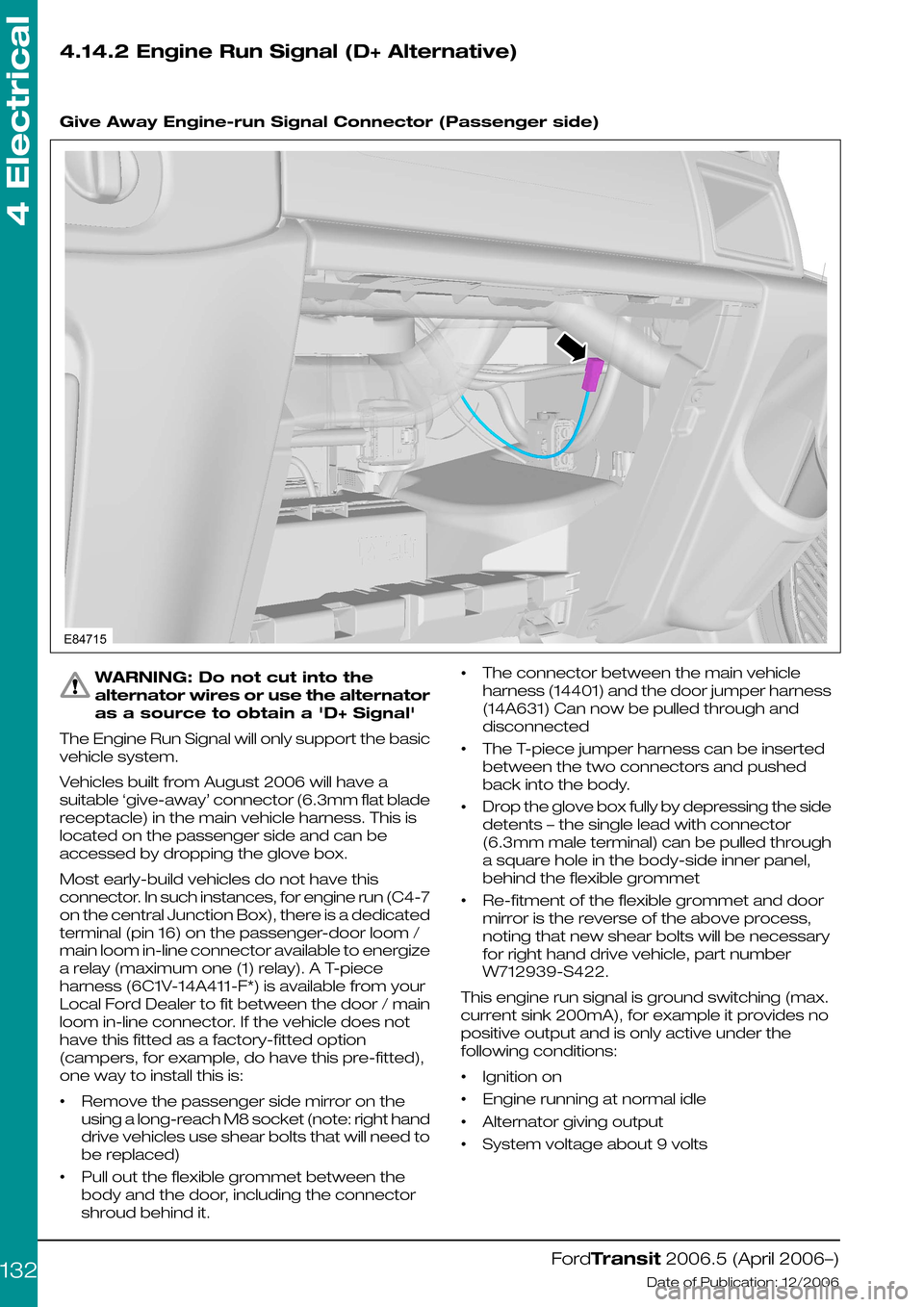
4.14.2 Engine Run Signal (D+ Alternative)
Give Away Engine-run Signal Connector (Passenger side)
WARNING: Do not cut into the
alternator wires or use the alternator
as a source to obtain a 'D+ Signal'
The Engine Run Signal will only support the basic
vehicle system.
Vehicles built from August 2006 will have a
suitable ‘give-away’ connector (6.3mm flat blade
receptacle) in the main vehicle harness. This is
located on the passenger side and can be
accessed by dropping the glove box.
Most early-build vehicles do not have this
connector. In such instances, for engine run (C4-7
on the central Junction Box), there is a dedicated
terminal (pin 16) on the passenger-door loom /
main loom in-line connector available to energize
a relay (maximum one (1) relay). A T-piece
harness (6C1V-14A411-F*) is available from your
Local Ford Dealer to fit between the door / main
loom in-line connector. If the vehicle does not
have this fitted as a factory-fitted option
(campers, for example, do have this pre-fitted),
one way to install this is:
•Remove the passenger side mirror on the
using a long-reach M8 socket (note: right hand
drive vehicles use shear bolts that will need to
be replaced)
•Pull out the flexible grommet between the
body and the door, including the connector
shroud behind it.
•The connector between the main vehicle
harness (14401) and the door jumper harness
(14A631) Can now be pulled through and
disconnected
•The T-piece jumper harness can be inserted
between the two connectors and pushed
back into the body.
•Drop the glove box fully by depressing the side
detents – the single lead with connector
(6.3mm male terminal) can be pulled through
a square hole in the body-side inner panel,
behind the flexible grommet
•Re-fitment of the flexible grommet and door
mirror is the reverse of the above process,
noting that new shear bolts will be necessary
for right hand drive vehicle, part number
W712939-S422.
This engine run signal is ground switching (max.
current sink 200mA), for example it provides no
positive output and is only active under the
following conditions:
•Ignition on
•Engine running at normal idle
•Alternator giving output
•System voltage about 9 volts
FordTransit 2006.5 (April 2006–)
Date of Publication: 12/2006
4 Electrical
132E84715
Page 153 of 234
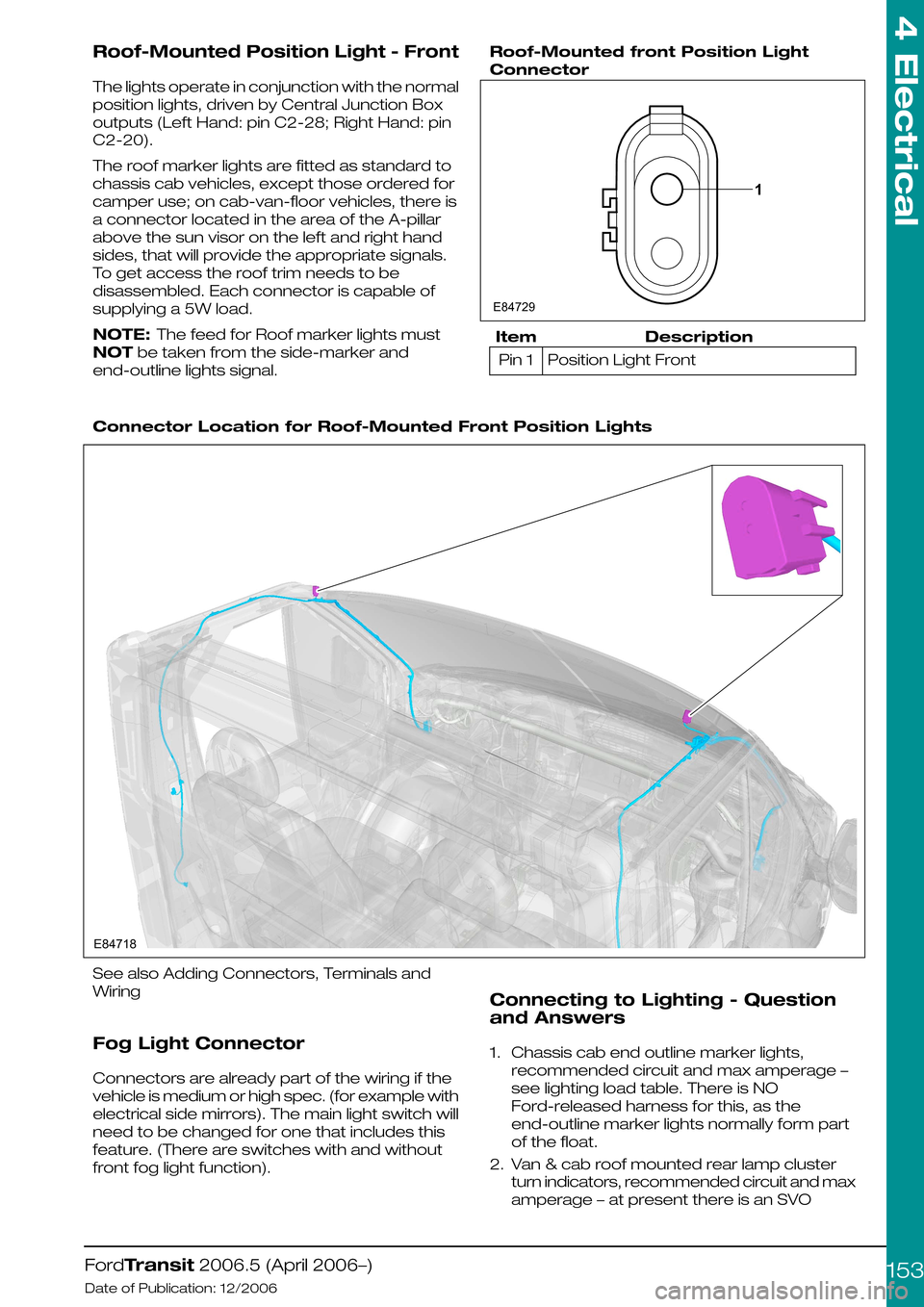
Roof-Mounted Position Light - Front
The lights operate in conjunction with the normal
position lights, driven by Central Junction Box
outputs (Left Hand: pin C2-28; Right Hand: pin
C2-20).
The roof marker lights are fitted as standard to
chassis cab vehicles, except those ordered for
camper use; on cab-van-floor vehicles, there is
a connector located in the area of the A-pillar
above the sun visor on the left and right hand
sides, that will provide the appropriate signals.
To get access the roof trim needs to be
disassembled. Each connector is capable of
supplying a 5W load.
NOTE: The feed for Roof marker lights must
NOT be taken from the side-marker and
end-outline lights signal.
Roof-Mounted front Position Light
Connector
DescriptionItem
Position Light FrontPin 1
Connector Location for Roof-Mounted Front Position Lights
See also Adding Connectors, Terminals and
Wiring
Fog Light Connector
Connectors are already part of the wiring if the
vehicle is medium or high spec. (for example with
electrical side mirrors). The main light switch will
need to be changed for one that includes this
feature. (There are switches with and without
front fog light function).
Connecting to Lighting - Question
and Answers
1.Chassis cab end outline marker lights,
recommended circuit and max amperage –
see lighting load table. There is NO
Ford-released harness for this, as the
end-outline marker lights normally form part
of the float.
2.Van & cab roof mounted rear lamp cluster
turn indicators, recommended circuit and max
amperage – at present there is an SVO
FordTransit 2006.5 (April 2006–)
Date of Publication: 12/2006
4 Electrical
1531E84729 E84718
Page 154 of 234

harness that provides roof-mounted rear turn
indicators, powered via relays. This should be
used in conjunction with SVO fusebox.
3.Chassis cab LED rear lamp cluster
replacement recommendations, especially
turn indicator relay implications – see lighting
load table. Generally the use of LED equivalent
lighting systems reduces the electrical load on
the vehicle; however, special care needs to
be taken with respect to any change to or
addition of turn indicator lights. Depending on
the current requirements of the LED(s)
compared to the bulb it is replacing, a ballast
resistor may be required, if not already
integrated into the LED lamp assembly.
Without this, bulb outage detection for turn
indicators will be affected, which is a legal
requirement.
Additional turn indicators must be powered
through relays (max 300mA), driven by existing
turn lights. The maximum load that the Central
Junction Box can drive is 3 x 21W per side (front,
rear and CAT 6 turn indicators); but even if the
vehicle is not fitted with the CAT 6 lights, the feeds
for these should not be used as the Central
Junction Box would need reconfiguring, which
could have safety as well as functional
implications.
4.Special Vehicle Option beacon switch: wiring
locations, circuit diagrams and max amperage
– see Special Vehicle Option fuse box
schematic (max current is 15A); there is
provision for the Special Vehicle Option beacon
switch in an empty switch location on the
instrument panel.
5.Rear loom connector detail location and supply
details for retro-fit loom extension for
example:- when extending a medium wheel
base, long wheel base or extended frame
overhang, what connectors do they use to
make a plug and play loom extension? – for
chassis cab vehicles, there is an Special
Vehicle Option extension loom for rear lamps
(part number 6C1V-14408-A*). There is not, at
present, a similar loom for Van, Bus and
Kombi's, although the appropriate mating
connector is now tooled, so this would be
possible.
Miscellaneous Systems
Handbrake on - Cluster Warning Light -
Unless the vehicle is specified with options that
drive the handbrake warning light (for example
ESP, Australia market), the components making
up this system are not fitted. We do not
recommend installation of this feature as an
aftermarket addition. There are several reasons
for this:
1.Not all circuits carry the requisite wire as a give
away:
•The wires might be part of the main vehicle
harness (14401) even if not used – for example
camper vehicles are normally ordered with
power mirrors, and the wires will be present
as a give-away.
•The seat pedestal harness (14K076), however,
is vehicle specific – if the handbrake is not part
of the specification, it will not be present or
give-away. This harness would need to be
changed to the compatible part that also
includes the handbrake warning light circuit.
2.The handbrake switch (part number
2F2T-15852-A*) together with its short jumper
harness (6C1T-15K857-A*) would need to be
obtained and fitted.
3.The handbrake warning light is in all clusters,
but unless the vehicle config. parameter
“parking brake switch” is set, the Central
Junction Box will not read this input, and hence
NO CAN message sent to the cluster.
Reconfiguration can only be done at a Ford
Dealer.
NOTE: If a vehicle already has a handbrake
warning light in the cluster, or one is installed as
per the Ford design, it is not possible to utilize the
wire from the handbrake switch as part of an
interlock circuit (this is a pull up resistor input that
provides a wetting current of 20mA – anything in
excess of this, for example through additional
circuitry, will almost certainly damage the Central
Junction Box). If there is no handbrake switch
installed, it would be possible to add one and
utilize this as part of a separate circuit, up to a
maximum current of 500mA through the switch.
Reverse Sensors (Rear Park Aid
Module)- The factory-fit option is a CAN-based
system, but for Van, Bus, and Kombi vehicles
only. Stand-alone systems can be installed (for
example for chassis cab conversions), but would
need to utilize the PTA line of the radio if muting
is required.
Fuel Fired Heater (FFH)- Add FFH: wiring is
only present (give-away) in certain harnesses.
There was an aftermarket kit available for this
system on current Transit, which could probably
be “updated” to suit V347/8.
Fuel Fired Heater (FFH) - Programmable
FFH: this utilizes a timer/control module mounted
to the Instrument Panel, which necessitates
having the correct Instrument Panel harness
fitted. Retrofit of this would be a difficult.
For both systems, the appropriate 6C1T-14K132
harness would be required (suffix -A* for
Programmable FFH, and suffix –B* for Add FFH).
Central Locking
Locking is controlled by the Central Junction Box
module. There is current sensing on certain
locking circuit pins as part of the security system
– if these are tampered with, locking cannot be
guaranteed.
FordTransit 2006.5 (April 2006–)
Date of Publication: 12/2006
4 Electrical
154
Page 172 of 234
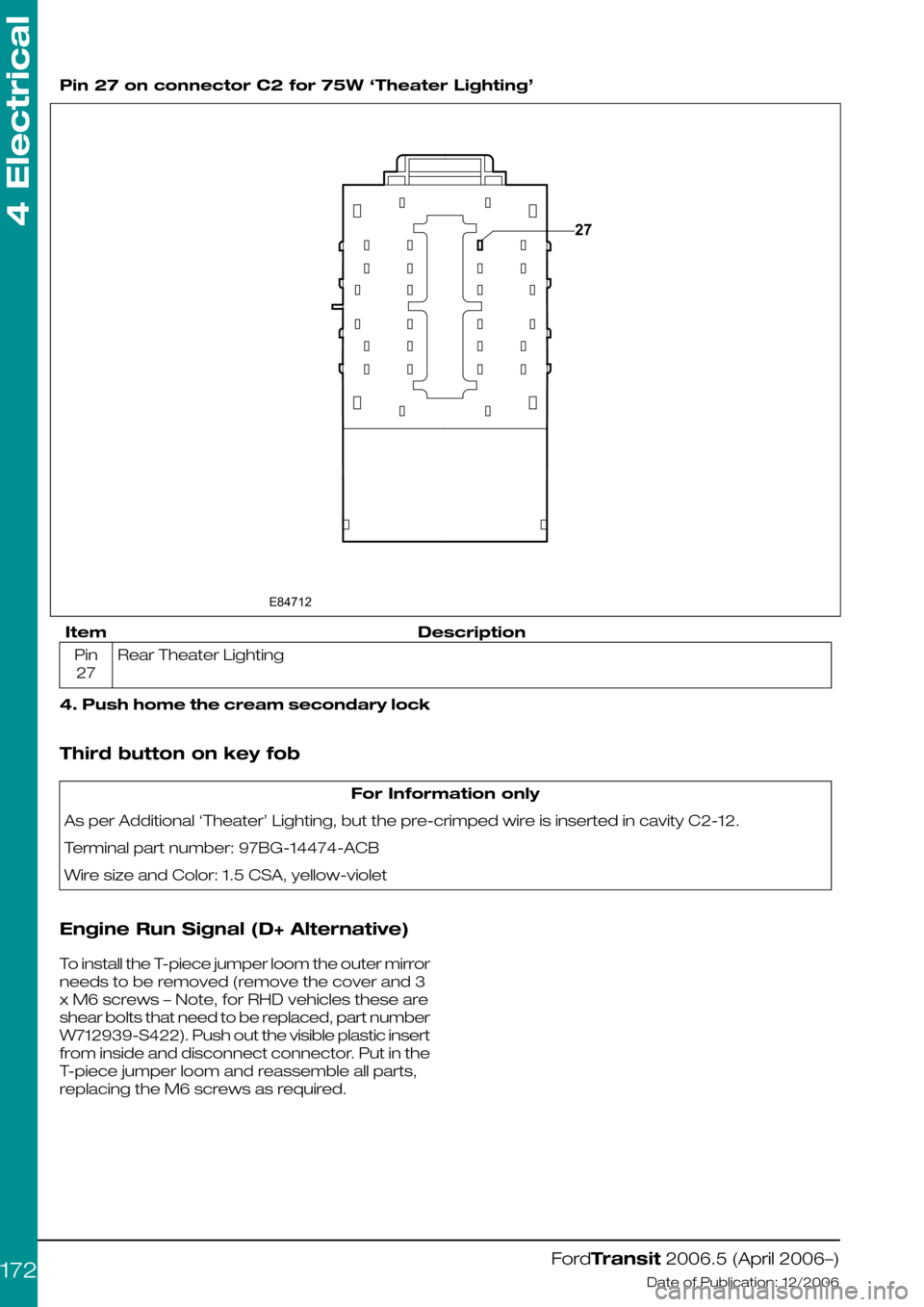
Pin 27 on connector C2 for 75W ‘Theater Lighting’
DescriptionItem
Rear Theater LightingPin
27
4. Push home the cream secondary lock
Third button on key fob
For Information only
As per Additional ‘Theater’ Lighting, but the pre-crimped wire is inserted in cavity C2-12.
Terminal part number: 97BG-14474-ACB
Wire size and Color: 1.5 CSA, yellow-violet
Engine Run Signal (D+ Alternative)
To install the T-piece jumper loom the outer mirror
needs to be removed (remove the cover and 3
x M6 screws – Note, for RHD vehicles these are
shear bolts that need to be replaced, part number
W712939-S422). Push out the visible plastic insert
from inside and disconnect connector. Put in the
T-piece jumper loom and reassemble all parts,
replacing the M6 screws as required.
FordTransit 2006.5 (April 2006–)
Date of Publication: 12/2006
4 Electrical
172E8471227